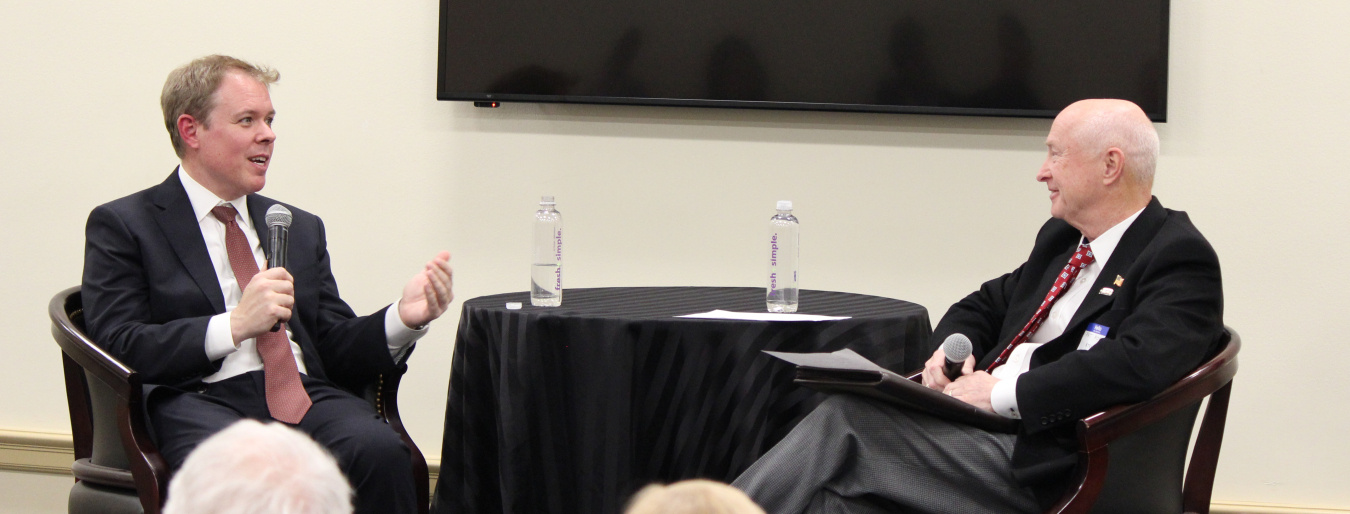White Cites EM Achievements, Cleanup Progress at Caucus Event
Office of Environmental Management
November 19, 2019
WASHINGTON, D.C. – Ike White said at an event of the House Nuclear Cleanup Caucus last week he was encouraged by progress he has seen at EM sites during his first months as head of the cleanup program, and his focus is on continuing successful execution of the EM mission.
White, former Chief of Staff and Associate Principal Deputy Administrator at the National Nuclear Security Administration, became head of the EM program in June. He said he expected a climb to get up to speed on the complexity and difficulty of the mission.
However, he said, “one of the things I have been most pleased with over the last four or five months of visiting all the sites is being able to see the real progress being made at just about every EM site.”
White accompanied Energy Secretary Rick Perry to Hanford to mark the completion of sludge removal from the K Basin to the T Plant at the site’s central plateau, an achievement greatly reducing risk to the Columbia River. At Oak Ridge, White recognized small businesses that have contributed to successful acceleration of cleanup.
At Savannah River, White took part in ceremonies noting the successful mission completion of the Actinide Removal Process (ARP) and Modular Caustic Side Solvent Extraction Unit (MCU), a forerunner to the Salt Waste Processing Facility (SWPF) that is preparing for operation. At Idaho, he congratulated the workforce for the upcoming completion of the waste treatment mission of the Advanced Mixed Waste Treatment Project.
Even the Moab Uranium Mill Tailings Remedial Action (UMTRA) Project, one of EM’s smaller sites, celebrated having relocated 10 million tons of tailings from Moab to an engineered disposal cell 35 miles away in Crescent Junction.
“I think it is on us — for both EM and the companies that support our work — to demonstrate that the investments made in cleanup actually accomplish real results,” White said. “The thing that has been impressive to me so far is actually seeing those results and seeing what real progress is being made, and for all of us collectively to make sure that continues.”
White spoke at a Capitol Hill event organized for the caucus, the organization of members of Congress who represent communities where DOE is remediating former nuclear weapons production and research sites. The event was moderated by Pat Hopper, president of the Energy Technology and Environmental Business Association (ETEBA). Caucus chair Rep. Chuck Fleischmann of Tennessee, and Reps. Joe Wilson of South Carolina and Bill Foster of Illinois, also spoke.
“One thing is for certain. Whether you are a Republican or a Democrat, in the House or Senate, the support for EM is incredible,” Fleischmann said. “This administration has been very strong, the House and Senator appropriators and authorizers have been very strong. As Americans, not Republicans or Democrats, we owe a duty to the affected communities to clean up the legacy waste wherever they are in Savannah River, Oak Ridge, Hanford. You name it, we will clean it up.”
In his remarks, White noted that while EM has completed about 90 percent of the cleanup area it was given when the program was established 30 years ago, tasks at the remaining 16 sites are among the most challenging.
“The focus over the next couple of years is on making sure we are doing the kinds of things we need to do to make progress on the hardest part of the mission that is coming up,” White said. In addition to startup of SWPF at Savannah River, the Integrated Waste Treatment Unit at the Idaho site and the Direct Feed Low Activity Waste (DFLAW) facilities at Hanford are expected to come online. The projects will enable EM to accelerate progress in processing tank waste, one of the most challenging waste streams.
“One of the things I hadn’t really thought about before is how much EM is investing in starting up nuclear operating capabilities,” White said. “We will be starting up three different capabilities in three different states treating tank waste. That will provide further opportunities to make real progress.”

